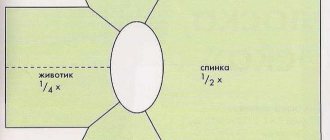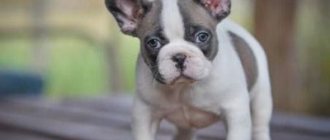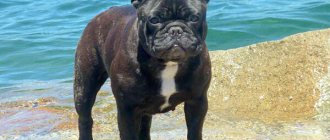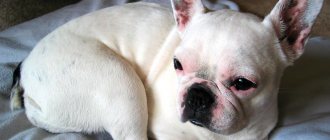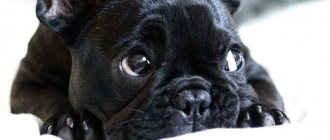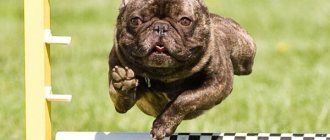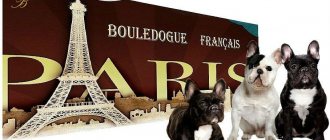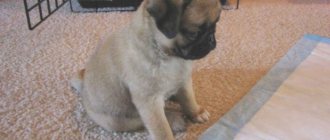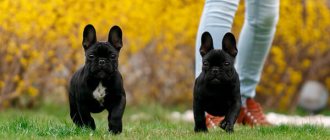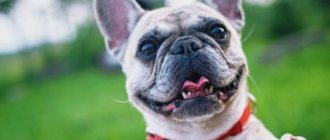Breed standards
Height at withers: 38-43 cm Weight:
- less than 6.8 kg;
- from 6.8 kg to 9 kg;
- from 9 kg to 11 kg.
Color: brindle; black (with spots of white); seal (looks indistinguishable from black, but when exposed to bright light it begins to shimmer red). Mandatory white markings: eye marks, lining around the muzzle, chest.
- The coat is smooth and short.
- Square body, graceful tail, short back and deep chest.
- The muzzle is short and square.
- The eyes are large, round, dark in color.
- The ears are cropped (but this may interfere with a show career) or remain natural - erect.
- The paws are small, the nails are short; straight limbs are located parallel, muscles are developed.
Brief information about the French Bulldog breed
The dog's ears are erect, wide at the base, slightly tapering towards a rounded tip. The brow ridges, protruding above the eyes, are separated from each other by a deep groove.
The eyes are round and large, with dark rims.
The dog looks like a typical fighting dog, but of a small format - stocky, smooth-haired, powerful, muscular, with a short tail and muzzle.
The height of males is 27-35 cm, weight 9-14 kg.
Bitches have the following dimensions: height 24-32 cm, weight 8-13 kg.
Read a more detailed description of the breed here.
Character
This is a companion dog, you can easily have fun with it - cheerful and active, at the same time it has a stable psyche and loves children.
Treats guests calmly.
This breed is balanced, trainable - brave, smart, friendly and has a good memory .
Dogs have developed reactions and muscles.
Dogs of this breed are not very suitable for the role of watchman and bodyguard.
It can show aggression towards other dogs and cats, attack larger breeds, but this depends on the individual qualities of the dog’s character.
Color
The main coat colors are white with or without spots, white-brindle, fawn, black-brindle.
Characteristics of colors:
- The brindle is characterized by frequent inclusions of red hair on black fur, or vice versa, black hair on red hair.
- The spotted color is distinguished by the presence of variegated brindle spots on a white background. They are located on the ears, head, sides and back.
- Fawn ranges from bright red to café au lait. A white blaze to the nose is allowed on the head of fawn dogs. Other spots on the head are considered defective.
Gray-blue color , blue brindle, chocolate, chocolate brindle, tricolor, fawn with blue mask, Isabella, merle, pure black are also considered color deviations .
Differences between a Boston Terrier and a French Bulldog
The Boston Terrier and the French Bulldog are significantly different. Boston looks like a miniature boxer - straight paws, tucked belly, minimal wrinkles on the muzzle, elegant neck, wide chest,
French bulldogs have slight curvature of the limbs, a roundish (barrel-shaped) chest, and almond-shaped eyes.
The Boston Terrier breed standards limit the possible colors; the French have more varied colors.
Bostons do not show aggression, they are less irritable than French bulldogs, but they can stand up for themselves and their owner.
A little about the Boston Terrier breed
The Boston Terrier was developed in the 19th century by crossing an English Bulldog with an English Terrier, then adding blood from other breeds..
Dogs of this breed have a square head, pronounced cheekbones and eye sockets. The lips are fleshy, the upper jaw, and the muzzle are also square in shape. Dogs do not have a powerful jaw.
The nose is large, the nostrils are pronounced and open. The eyes are large and round.
The iris of the eye is as black as possible. The ears are small, erect, the ends are rounded, and can be cropped.
The body is square, of moderate width.
The dog has elongated limbs and its tail is low . It is short, tapering towards the end.
Males in this breed are larger than females.
Height is equal to the length of the back, and weight can have three options:
- Lightweight - no more than 6.8 kg.
- Average – 6.8-9 kg.
- Heavy – 9-11.3 kg.
A dog of this breed lives for about 15 years.
Main features
Dogs of this breed are excellent companions, vigilant guards, and are perfect for the role of family friend.
This is a very energetic dog that is capable of mischief if left alone for a long time . But do not overdo it with punishment - this breed is very sensitive and touchy.
Boston Terriers are playful and mischievous and love to attract the attention of others. The dog gets along well with children; she loves toys and outdoor games.
This breed also gets along well with other pets and often forms strong friendships with them.
Since the Boston Terrier inherited fighting genes, the dog may want to compete with his brother during a walk..
It is important to avoid such conflicts and educate the dog properly.
The dog is trusting and friendly towards humans.
She can even go off with a stranger, so you should always keep a close eye on her or never let her off the leash. Special training will teach the dog to be distrustful of strangers.
Colors
Boston Terriers have short hair that lies close to the body in all places.
Purebred individuals have the following types of colors:
- Black and white – black with white markings. The nose and eyes are also black. This is the most common color of Boston Terriers.
- Fur seal (seal) - in appearance it seems that the color is no different from black and white - the spots are located in the same places, but in sunlight or bright light the fur takes on a reddish tint.
- Brindle (variegated) – the dog has brindle hair of a light or dark shade. It is important that brindles must be distinguishable. The nose is black, the eyes are dark brown. This color is preferred when the dog is well equipped.
All other colors are acceptable, but are not recognized by the FCI standard . These are red, liver or chocolate, fawn, cream, gray, blue-fawn, piebald, tri-color and albino.
History of the breed
Boston Terriers appeared in the 19th century in Massachusetts (Boston). In 1865, Robert Huppert acquired a male bull and terrier , who after some time became the owner of a neighbor's dog. The puppies turned out surprisingly similar to their father. This offspring became the starting point in breeding a new breed.
In 1878 they already participated in exhibitions. The peak of popularity occurred in the 20s of the twentieth century, when these sturdy ones became fashionable among rich ladies. In 1981, the first breed club was created, and already in 1983 the breed was recognized as independent.
Dog handlers began to actively work to improve the breed - Bostons were crossed with a boxer, with an Old English white terrier, a French and English bulldog, a bull terrier and even with a pit bull. As a result, the dogs became more elegant and acquired a unique set of psychological characteristics.
The breed standard was first adopted in 1891, and the final one in 1998.
Similarities
The main similarity in the comparison of the Boston Terrier and the French Bulldog is that these dogs have common ancestors and both, according to the ICF classification, belong to the Small Molossoids. There is also a similarity in size: representatives of these breeds weigh approximately 8 - 12 kg. They are also very similar in head structure: both the Boston and the French have rather large and convex skulls, and their muzzles are wide, upturned and greatly shortened. In addition, undercutting is also their characteristic natural feature, as are erect ears, slightly rounded at the ends, folds on the head, strong paws and short tails.
What these breeds have in common is that for the representatives of each of them, the brindle color, complemented by white markings, is considered standard. The Bulldog and the Boston Terrier have another common feature that some owners find cute, but other owners find annoying. The fact is that representatives of both breeds snore quite heavily in their sleep. This is due to the structure of their shortened muzzles, which is characteristic of all brachycephals.
Both breeds are similar not only in appearance, but also in character: both dogs are sociable, playful, friendly and energetic.
They are equally devoted to their owners, get along well with children, are smart and train well.
However, the stubbornness inherent in both of these breeds also makes their representatives similar, as is the fact that both the bulldog and the Boston terrier require respectful treatment.
Such pets will become good guards, although aggression towards people is not inherent in bulldogs or Boston terriers by nature.
But both the French bulldog and the Boston terrier are distinguished by a unique sense of humor: they have very rich facial expressions, which seem to be able to express the whole gamut of emotions and feelings. Another important similarity is that caring for a Boston Terrier and a French Bulldog is not difficult, since they are both short-haired and very comfortable to keep in a house or apartment.
Temperament and character
The Boston Terrier is a family dog that loves its owners infinitely. They prefer to be with their owner everywhere, making the breed suitable for people who travel. Dogs are cheerful and active.
They can be characterized as follows:
- mentally balanced;
- active;
- playful;
- devotees;
- non-aggressive;
- sociable.
Video "Boston Terrier"
From this video you will learn everything about the Boston Terrier breed.
Recommended Posts
Description and characteristics of all types of terriers
Description of the small and amazing West Highland White Terrier
38 best dog breeds for apartments according to reviews from breeders and owners
Little Hunter or Australian Silky Terrier
Description of the breed with a 400-year history of the Manchester Terrier
Description of the breed and everything about keeping the Parson Russell Terrier
Boston Terrier and man
These are amazingly sociable dogs , so they are suitable for single people and large families. He gets along well with pets and children.
When purchasing a Boston, you can be sure that true happiness will live in your home. These are excellent companions, completely devoid of unmotivated aggression , easy to care for and unpretentious.
The small size, intelligence and character inherent in the breed, easy training - all this together makes keeping a dog problem-free both in a private house and in an apartment.
Character and education
The Boston Terrier is a cheerful and good-natured dog, friendly to people, including strangers. Most often she is equally attached to all family members. Prefers to spend all his time among people (to the point of obsession).
Playful and energetic. He gets along well with children and is drawn to them, tolerates and even loves rough games (but you still need to keep an eye on it so that the child does not harm the pet). The Boston Terrier can be an excellent companion for an older person.
Males sometimes clash with other males, but in most cases these dogs get along well with other animals, including smaller ones. They often try to play with cats, although the latter do not always approve of such impulses. The Boston Terrier remembers commands well and is capable of learning many funny tricks. Tries to please the owner and almost does not strive to dominate, therefore it is recommended for novice dog breeders. Young animals can be stubborn, but with patient and consistent training this goes away.
In training, it is recommended to use the method of positive reinforcement, that is, reward more often for correct actions than punish for incorrect ones. Reviews from owners indicate that these gourmets work especially well for treats. Can participate in obedience and agility.
The problematic aspects are that Boston Terriers, like all small dogs, are not able to endure for long and can spoil in the apartment. Also due to the peculiarities of physiology, they suffer from flatulence, snore loudly, and while awake they can wheeze, grunt and snort loudly. Long walks and games (especially with a ball) are recommended. If you don't let them throw out their energy, they can become real destroyers.
Similar article: Description of the breed with a 400-year history of the Manchester Terrier
Maintenance and care
Suitable for keeping even in a small apartment. But, it categorically does not tolerate living on the street , since it is not adapted to frost and bad weather.
This is an active dog, ready to walk for a long time. For an adult dog, the minimum walking time is 60-90 minutes , while activity in the form of games and training is desirable. You need to walk at least 2 times a day , the puppy is taken outside more often.
When going for a walk in bad or frosty weather, wear warm clothes . In the cold season, it is advisable to reduce the walking time.
Dogs can be fed:
- natural food - the diet should include meat, offal, vegetables, cereals;
- premium dry food.
An adult dog is fed morning and evening, a puppy 4-6 times. The largest meal is in the evening.
You need to regularly examine your teeth, coat, eyes, and ears. You should not wash it often (only when necessary - for example, after walking through mud), and brush the coat with a stiff-bristled brush. It is necessary to trim the nails if they do not grind down naturally.
Education and training
The dog lends itself well to training - at home and professionally. First, you need to teach the puppy the rules of behavior in the house, and after six months you can attend classes conducted by an instructor and undergo a “basic training course” (BTC) under his guidance. A trained dog will not cause inconvenience to the owner and others.
Training should be done in a playful way . To keep your dog from getting bored, you can practice agility, take your pet to swim in ponds, or go into the forest.
Health and life expectancy
Boston Terriers live up to 11-15 years .
Representatives of the breed are endowed with good health, but the following diseases occasionally occur:
- respiratory;
- a brain tumor;
- endocrine (Cushing's syndrome);
- mastocytoma;
- cataract;
- congenital deafness;
- intestinal disorders.
For Bostonians, giving birth by cesarean section is a common practice. The reasons for this difference are the puppies' overly large heads.
Breed photo
A selection of photos of Boston Terriers.
Comparison of prices for puppies of these breeds
The price of a puppy, both Boston Terrier and French Bulldog, directly depends on the class, pedigree and titles of the parents. You can buy a breed-class puppy for up to $1,500.* If the puppy is of a rare color and ideal in external proportions, then the dog may cost more. For a show-class puppy you will have to pay from 500 to 1000 dollars.
For your information! The most affordable are puppies intended for home keeping. Their cost is about $300.
